

PROSTATE VOLUME CALCULATED BY BIPLANE PLANIMETRY IMPROVES THE ACCURACY OF PSA DENSITY.
A. Kimura, M. Yoshida, I. Saito, and T. Kitamura, Tokyo Kyosai Hospital, Tokyo, Japan
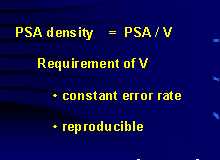
(1)(First slide please)
PSA density is the quotient of PSA divided by prostatic volume.For the calculation of PSA density, volume measured by US needs not to be the same with real prostatic volume. Requirements of volume measurent are constant error rate regardless of prostatic shape, and reproducibility.
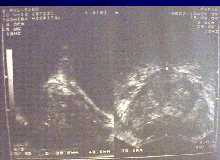
(2)(Next slide please)
For volume calculation, prolate ellipsoid is the most popular method. From the cross and sagittal section, width, height, and length are measured.
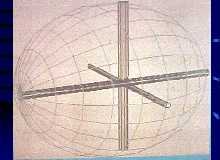
(3)(Next slide please)
Height times width times length times pi/6 gives the volume of prolate ellipsoid having the three axes.
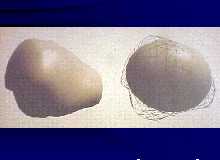
(4)(Next slide please)
The 3D models of BPH and prolate ellipsoid are shown. Prolate ellipsoid has a tendency to underestimate the volume in BPH,
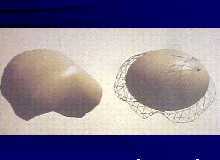
(5)(Next slide please)
because rectal surface of the prostate in BPH is pressed by ultrasonic probe.
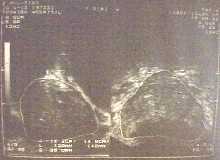
(6)(Next slide please)
Recently, we proposed a new calculation method which we termed "biplane planimetry". By this new method, the prostatic contours of both cross and sagittal sections are traced.
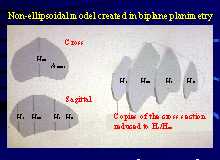
(7)(Next slide please)
Based on the cross and sagittal contours, a non-ellipsoidal model is created. The model is composed of sequentially arranged copies of the cross section. The copies are reduced to fit the contour of the sagittal section.
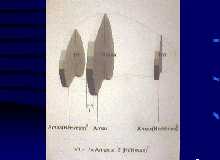
(8)(Next slide please)
The areas of the copies are reduced in proportion with the square of the height, and so the formula is :
slice thickness times Area max times the sum of the height reduction rates.
Amax is the area of the maximum cross section, and Hi are the heights measured at a certain interval in the sagittal section, the maximum of which is Hmax.
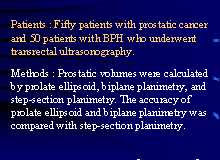
(9)(Next slide please)
Using transrectal sonograms of 50 patients with prostatic cancer and 50 patients with BPH, we previously compared the accuracy of prolate ellipsoid and biplane planimetry. Step-section planimetry was used as the gold standard.
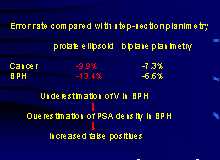
(10)(Next slide please)
Prolate ellipsoid underestimated the volume by 10% in cancer and by 14% in BPH, while the biplane planimetry underestimated the volume by 7% both in cancer and BPH. Biplane planimetry has the same error rates in BPH and in cancer.
Underestimation of volume only in BPH leads overestimation of PSA density in BPH.
Therefore, the prolate ellipsoid has a risk to increase false positives of PSA density.

(11)(Next slide please)
Prolate ellipsoid and biplane planimetry were compared as denominators in PSA density .
In nineteen patients with prostatic cancer and twenty patients with BPH having intermediate PSA values, prostatic volumes were calculated both by prolate ellipsoid and biplane planimetry. For those whose PSA levels were measured several times, values measured just before the US guide biopsy were aplied.
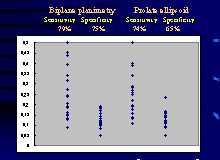
(12)(Next slide please)
The averages of PSA density by biplane planimetry were 0.28 in cancer and 0.12 in BPH, while those by prolate ellipsoid were 0.27 and 0.13 respectively. Using a cutoff of 0.15 as recommended in the literature, the sensitivity and specificity by biplane planimetry were 79% and 75%, while those by prolate ellipsoid were 74% and 65%.
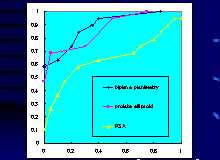
(13)(Next slide please)
Receiver operator characteristic curves were constructed for PSA, PSA densities by prolate ellipsoid and by biplane planimetry. The ROC curve of biplane planimetry came closer to the left and top boundaries than that of prolate ellipsoid. Areas under the curves were 0.64, 0.87, and 0.89 respectively.
As biplane planimetry does not underestimate the volume of BPH, the false positive rate of PSA density by biplane planimetry is smaller than that by prolate ellipsoid.
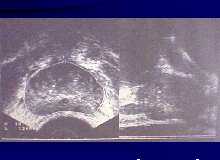
(14)(Next slide please)
Biplane planimetry is not available in ultrasonic console now used. So, in this study, only the cross section area was measured by the equipment. To measure the heights in the sagittal section, a transparent sheet with measures was overlaid.
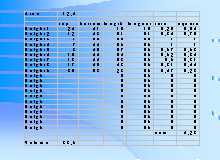
(15)(Next slide please)
Using the microsoft software: Exel, heights, the maximum, their rates to the maximum, their square, and their sum are obtained. Here, culculated the volume by biplane planimetry. It's a little bid cumbersome, so we could not get biplane planimetry prospectively. So, this study is a retrospective one.






















